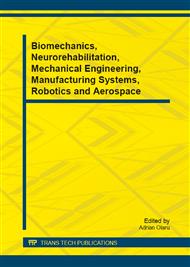[1]
C. Alexandru. Dynamic analysis of the guiding mechanisms used for the rear axle of the commercial vehicles. International Review of Mechanical Engineering, vol. 3, n. 1, pp.1-6, 2009.
Google Scholar
[2]
C. Alexandru. The kinematic optimization of the multi-link suspension mechanisms used for the rear axle of the motor vehicles. Proceedings of the Romanian Academy, Series A, vol. 10, n. 3, pp.244-253, 2009.
Google Scholar
[3]
M. Hiller, C. Woernle. Bewegungsanalyse Einer Fűnfpunkt – Radaufhangung. ATZ, vol. 87, n. 2, pp.59-64, 1985.
Google Scholar
[4]
D.M.A. Lee, D.M. Pascoe. Analysis of the multi-link suspension system. International Journal of Vehicle Design, vol. 14, n. 1, pp.44-58, 1993.
Google Scholar
[5]
P.A. Simionescu, D. Beale. Synthesis and analysis of the five-link rear suspension system used in automobiles. Mechanism and Machine Theory, vol. 37, n. 9, pp.815-832, 2002.
DOI: 10.1016/s0094-114x(02)00037-x
Google Scholar
[6]
T.K. Garrett, W. Steeds, N. Newton. The motor vehicles. Elsevier Butterworth-Heinemann, 2001.
Google Scholar
[7]
H. Heisler. Advanced vehicle technology. Elsevier Science Ltd., 2002.
Google Scholar
[8]
J. Reimpell, H. Stoll, J. Betzler. Automotive chassis: engineering principles. Elsevier Science Ltd., 2001.
Google Scholar
[9]
J. Knapczyk, S. Dzierzek. Effects of geometrical parameters and joint flexibilities on elasto-kinematic characteristics of five-rod rear wheel guide mechanisms. Proceedings of the IFToMM International Symposium - SYROM, Bucharest, 1993, vol. 4, pp.83-90.
Google Scholar
[10]
J. Knapczyk, M. Maniowski. Selected effects of bushings characteristics on five-link suspension elastokinematics. Mobility and Vehicle Mechanics, Vol. 3, n. 2, pp.107-121, 2002.
Google Scholar
[11]
E. Rocca, R. Russo. A feasibility study on elastokinematic parameter identification for a multilink suspension. Journal of Automobile Engineering, vol. 216, n. 2, pp.153-160, 2002.
DOI: 10.1243/0954407021528995
Google Scholar
[12]
J. Garcia de Jalón, E. Bayo. Kinematic and dynamic simulation of multibody systems. Springer - Verlag, 1994.
Google Scholar
[13]
J. Haug. Computer aided analysis and optimization of mechanical system dynamics. NATO ASI, series F, vol. 9, Springer-Verlag, 1984.
Google Scholar
[14]
W.O. Schiehlen. Multibody systems dynamics: roots & perspectives. Multibody Systems Dynamics, vol. 1, n. 2, pp.149-188, 1997.
DOI: 10.1023/a:1009745432698
Google Scholar
[15]
*** Getting started using ADAMS/View & Solver. MSC Software Press, 2005.
Google Scholar


